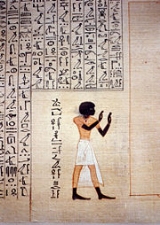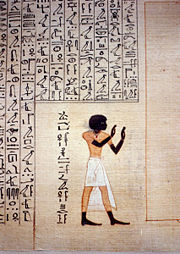
Maiherpri
Encyclopedia

Ancient Egypt
Ancient Egypt was an ancient civilization of Northeastern Africa, concentrated along the lower reaches of the Nile River in what is now the modern country of Egypt. Egyptian civilization coalesced around 3150 BC with the political unification of Upper and Lower Egypt under the first pharaoh...
ian noble of Nubia
Nubia
Nubia is a region along the Nile river, which is located in northern Sudan and southern Egypt.There were a number of small Nubian kingdoms throughout the Middle Ages, the last of which collapsed in 1504, when Nubia became divided between Egypt and the Sennar sultanate resulting in the Arabization...
n origin buried in the Valley of the Kings
Valley of the Kings
The Valley of the Kings , less often called the Valley of the Gates of the Kings , is a valley in Egypt where, for a period of nearly 500 years from the 16th to 11th century BC, tombs were constructed for the Pharaohs and powerful nobles of the New Kingdom .The valley stands on the west bank of...
, in tomb KV36
KV36
Tomb KV36, located in the Valley of the Kings in Egypt, was used for the burial of the noble Maiherpri from the Eighteenth Dynasty.Rediscovered by Victor Loret in March 1899, the tomb was found to be substantially undisturbed, but as it has for a long time not properly published, it is not as well...
. He probably lived during the rule of Thutmose IV
Thutmose IV
Thutmose IV was the 8th Pharaoh of the 18th dynasty of Egypt, who ruled in approximately the 14th century BC...
, and received the honour of a burial in the Valley of the Kings
Valley of the Kings
The Valley of the Kings , less often called the Valley of the Gates of the Kings , is a valley in Egypt where, for a period of nearly 500 years from the 16th to 11th century BC, tombs were constructed for the Pharaohs and powerful nobles of the New Kingdom .The valley stands on the west bank of...
, the royal necropolis
Necropolis
A necropolis is a large cemetery or burial ground, usually including structural tombs. The word comes from the Greek νεκρόπολις - nekropolis, literally meaning "city of the dead"...
. His name can be translated as Lion of the Battlefield,. Amongst his titles were Child of the Nursery and Royal Fan-Bearer of the Right Hand Side. There is speculation that the first title signified that he grew up in the royal nursery as a prince of a vassal
Vassal
A vassal or feudatory is a person who has entered into a mutual obligation to a lord or monarch in the context of the feudal system in medieval Europe. The obligations often included military support and mutual protection, in exchange for certain privileges, usually including the grant of land held...
territory, or perhaps was the son of a lesser wife or concubine of the pharaoh. He was among the first during the New Kingdom
New Kingdom
The New Kingdom of Egypt, also referred to as the Egyptian Empire is the period in ancient Egyptian history between the 16th century BC and the 11th century BC, covering the Eighteenth, Nineteenth, and Twentieth Dynasties of Egypt....
to hold the second title, and was literally true in that he was by the pharaoh's side, likely as an advisor or bodyguard. This same title was also used to denote the Viceroy
Viceroy
A viceroy is a royal official who runs a country, colony, or province in the name of and as representative of the monarch. The term derives from the Latin prefix vice-, meaning "in the place of" and the French word roi, meaning king. A viceroy's province or larger territory is called a viceroyalty...
s of Kush
Kingdom of Kush
The native name of the Kingdom was likely kaš, recorded in Egyptian as .The name Kash is probably connected to Cush in the Hebrew Bible , son of Ham ....
later in the New Kingdom.
Tomb of Maiherpri
In Maiherperi's tomb, a papyrusPapyrus
Papyrus is a thick paper-like material produced from the pith of the papyrus plant, Cyperus papyrus, a wetland sedge that was once abundant in the Nile Delta of Egypt....
was found depicting him with literally "blackish" skin, leading scholars to believe he was in fact Nubia
Nubia
Nubia is a region along the Nile river, which is located in northern Sudan and southern Egypt.There were a number of small Nubian kingdoms throughout the Middle Ages, the last of which collapsed in 1504, when Nubia became divided between Egypt and the Sennar sultanate resulting in the Arabization...
n or of Nubian descent. The papyrus in question was the Book of the Dead
Book of the Dead
The Book of the Dead is the modern name of an ancient Egyptian funerary text, used from the beginning of the New Kingdom to around 50 BC. The original Egyptian name for the text, transliterated rw nw prt m hrw is translated as "Book of Coming Forth by Day". Another translation would be "Book of...
, in the eyes of O'Connor and Cline "[c]ertainly the most famous and arguably the most beautiful" Book of the Dead..
The mummy was unwrapped by Georges Daressy in March 1901, revealing a mummy whose dark skin matched that depicted on his copy of the Book of the Dead, and thought that this was likely Maiherperi's natural colour, unchanged by the mummification process. He also had tightly curled, woolly hair, which turned out a wig that had been glued to his scalp.
External links
- The Tomb of Maihirpre - Pictures of the artifacts from Maiherpri's tomb
- Maiherpra

